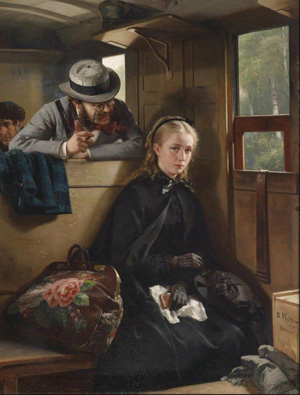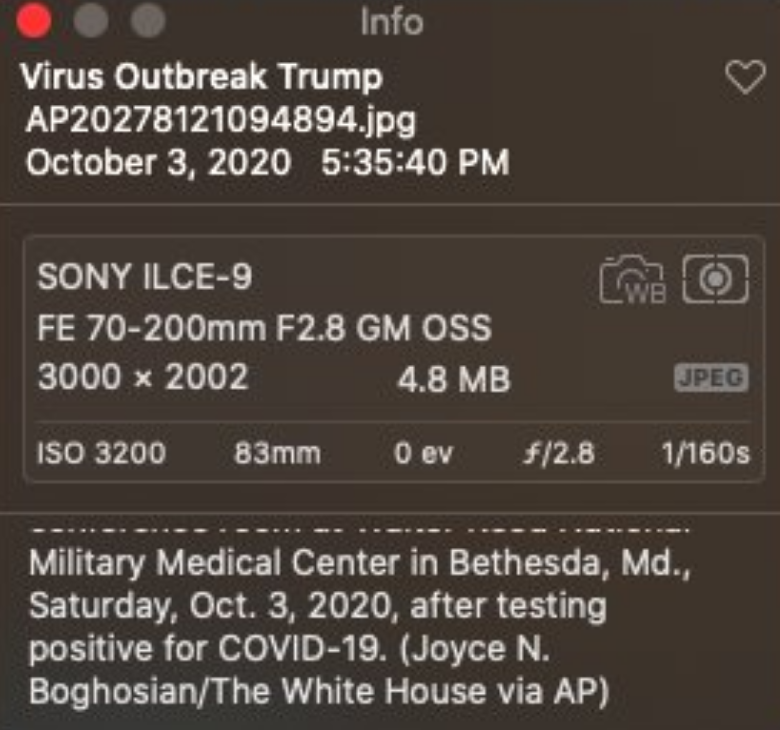This and its accompanying article are about the probability that the Trump hospital pictures were taken on the date and at the time appearing from the published screenshots of the EXIF viewer. This shouldn’t need saying. but they are not advanced treatises, still less advice, on all the technical and legal issues which can arise when handling electronic data. For that you will want to take specialist advice.
The painting “The Irritating Gentleman” by Berthold Woltze is well known now, often used to illustrate mansplaining. It was only when I looked for it as an illustration for this post that I discovered that “Irritating” was Woltze’s label for the man giving his unwanted views to a woman on a train. I had been casting around for a word to describe the people mentioned below, seeking a word slightly softer than the ones I used in the first draft. “Irritating” is perfect for the man (and it’s always a man) who dumps unhelpful comments against a social media post without any positive contribution to the discussion.
A little man on LinkedIn has challenged the premise of my article about the timing of the Trump hospital photographs. He was rude as well as wrong, but he is not worth powder and shot so I won’t identify him. Another man says that this was “Not the best example of what EXIF can do”. Gosh – how very remiss of me.
It seemed right, however, to double-check the point made by the first observation, and to deal briefly with the second. I do not claim infallibility in this area, but there are two reasons why I felt confident of my ground as to to the dates and times of the photographs.
One is that I used to do data conversions, and became only too familiar with the difference between (for example) document creation dates, modification dates and copying dates, any of which may end up as the file system date. The other is that I spend an inordinate amount of my time handling RAW photograph files and exporting them to TIFF and .jpg, so I am familiar with the various date fields in photographs.
The fellow made three separate comments. One was not worth repeating. The second suggested that I was passing on “fake news”.

I don’t in fact do forensics reports. I wonder what it was about my article which prompted the reference to them. What was it that “reminded” him of fake reports and “bribes” and caused him to link them to my post?
There are ways and ways of signifying disagreement on an open professional forum. Accusing someone of purveying “fake news” and making snide references to fake reports and bribes is not how I would go about it. It is, at the least, irritating.
__________
The man’s question was put as “Did no-one think to check how RAW files are converted to jpg in photo-editing software?” with the implication that he knows, and I don’t, what dates appear after such conversion. Why am I so sure that the date on the Trump images is the date on which the photographs were taken and not the date of any subsequent export?
The viewer image we have seen simply gives a date, without specifying whether that is the date of creation or any subsequent export.
The image viewer is in fact Apple’s Photos app. What date does that show by default? Is it most likely to be the date on which the picture was taken or might it, as my correspondent suggests in his ill-mannered phrasing, be the date of a subsequent export?
I know the answer anyway, which is why my article’s conclusion is that the two pictures were taken ten minutes apart. Having been challenged on the point, however, we should test it. On 6 October, we exported from RAW (using Lightroom) a photograph which my son Will Dale took on 24 September 2020 at 07:01:52, and looked at the result in Apple Photos.
The information in the viewer shows this:
The resulting view is a replica of the Trump pictures. The date shown on it is the date on which the photograph was taken, not the date of export. It is reasonable to assume that the same applies to the Trump pictures.
__________
It is certainly true that EXIF data can be altered. Did the AP photographer do that? For one thing, it seems unlikely that a reputable news agency would tamper with EXIF data and then publish it in circumstances where it was obvious that the world’s eyes were going to be on the detail. For another, and as I observed in my post, if you were going to tamper with the dates in these circumstances, you would move them apart, and not bunch them together. I therefore stand by what I said in the article.
The internet is full of people scratching their heads over these photographs, including some who are determined to be even-handed and neutral about them. Most conclude that the photographs were taken in close sequence. Those who remain uncertain, have not reached any positive conclusion to the contrary, but ended up wondering why Trump’s social media people would commit such a self-own.
__________
What about the second commentator, the one who said this?
Doubtless there are other articles out there explaining EXIF data for a legal and eDiscovery audience, referencing a case in which it mattered, and fitting it into a topical context. Perhaps the chap would like to point us to them.
__________
I have used many technical and similar discussion forums over the years. For the most part, participants have been polite and helpful. Disagreements arise, based on differing experiences and varying skill levels, and it can be positively helpful to get alternative views. Occasionally, however, one comes across people who use them to sneer, without offering anything helpful. I don’t get that often, and I usually ignore them. Unlike the young widow in Woltze’s painting, I can give as good as I get if I choose to bother, but I have seen others being hurt by undeserved put-downs from people whose only purpose is to show some self-assumed superiority. They are always men.
The Irritating Gentleman by Berthold Woltze








